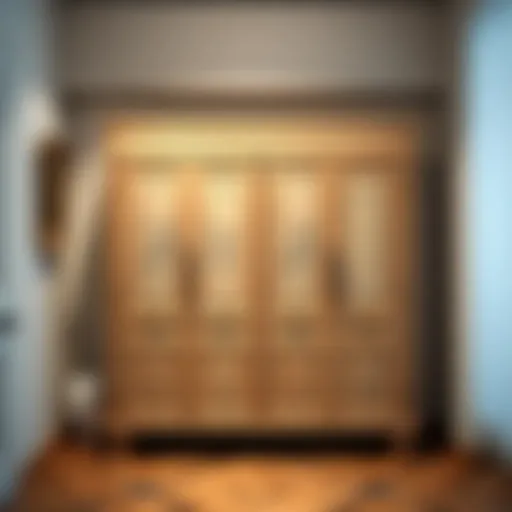Comprehensive Guide to Cube Storage Systems


Intro
When it comes to home organization, cube storage systems shine. They serve a practical purpose while also adding a modern aesthetic to various environments. Understanding the nuances of these systems reveals just how transformative they can be, whether you're tackling a cluttered living room or maximizing storage in a tight space. This article seeks to unravel the many layers of cube storage, examining everything from the basic design principles to their place in contemporary interior design.
Cube storage systems offer versatility and practicality. They provide a flexible solution that can adapt to personal style and needs. With a myriad of designs, colors, and materials available today, these systems cater to homeowners, designers, and DIY enthusiasts. Additionally, their application in sustainability efforts makes them even more appealing in the current market.
By diving into the functionality and potential of these storage solutions, we will explore how they can enhance organizational efficiency and impact your interior spaces positively. Let’s embark on this journey into the world of cube storage systems.
Furniture Styles and Trends
Modern vs. Traditional: Understanding the Aesthetics
There’s a stark contrast between modern and traditional cube storage designs. Modern systems often prioritize clean lines, minimalistic shapes, and innovative materials like metal, glass, or eco-friendly options. These designs focus on functionality while seamlessly blending into contemporary spaces. In contrast, traditional cube storage tends to lean on ornate detailing and classic woods, aiming to evoke a sense of nostalgia and warmth.
In today’s interiors, the trend is definitely leaning towards more modern interpretations. You’ll notice that many new cube systems boast modular designs, allowing homeowners to tailor their setups precisely to their needs. These configurations mean you can stack units or spread them out, creating a tailored organizational landscape. However, those with a fondness for the past can still find traditional or rustic cube storage options that echo timeless craftsmanship.
Color and Material Trends: What's In and What's Out
Color and material choices make a significant impact on the overall look and feel of cube storage systems. At present, earthy tones like olive green and terracotta are trending, as they bring warmth and a natural vibe to interiors. On the other hand, bright and bold hues like teal and mustard are being embraced for statement pieces that pop in a room.
Materials are also evolving. Sustainable materials are making waves in storage solutions. Bamboo and reclaimed woods are becoming popular choices for homeowners who wish to honor eco-friendly practices. Such materials not only contribute to a lower carbon footprint but also add character and uniqueness to each piece.
When selecting colors and materials for cube storage systems, it’s essential to consider your existing decor as well as potential future changes.
"Choosing the right cube storage system is not just about aesthetics; it’s about creating a harmonious blend with your home’s style and personality."
Furniture Care and Maintenance
Tips for Prolonging the Life of Your Furniture
Maintaining cube storage systems involves more than just occasional dusting. Here are some practical tips to help keep your furniture in tip-top shape:
- Avoid Direct Sunlight: Prolonged exposure can fade colors, especially for wood and fabric materials.
- Regular Cleaning: Use a soft cloth and gentle cleanser. For wooden surfaces, consider using a specially formulated wood cleaner.
- Inspect for Wear: Regularly examine joints and hinges, particularly on modular units, to ensure everything remains sturdy.
DIY Repair Hacks for Common Furniture Issues
Should you experience a mishap with your cube storage system, don’t fret. Here are a couple of simple hacks:
- Scratches on Wood: You can use a walnut to rub on minor scratches, as the oils will help disguise imperfections. Alternatively, a mix of vinegar and olive oil can work wonders too.
- Loose Shelves: If you're dealing with sagging shelves, consider placing adhesive shelf support pins to better distribute weight.
Understanding how to care for your cube storage and perform small repairs ensures a longer lifespan and continued functionality.
As we’ve seen, cube storage systems offer much more than just a place for your belongings. They reflect contemporary design trends and a commitment to maximizing space efficiently. Keep these insights in mind as you venture into the world of storage solutions, and appreciate the difference a well-thought-out cube system can make in your home.
For further reading on interior design trends and organizing solutions, explore resources such as Wikipedia and Reddit.
Consider how cube storage might fit within your own design vision — it may just be the upgrade your space deserves.
Preamble to Cube Storage Systems
Cube storage systems have emerged as a pivotal solution in contemporary design, altering not just how we store items but also how we think about space itself. By maximizing vertical and horizontal areas, these units offer practical benefits while adding an aesthetic element to various environments. This introduction aims to delve into the fundamental aspects of cube storage systems, highlighting their significance and the myriad advantages they bring.
Definition and Concept
At its core, a cube storage system comprises modular units that allow for both organization and display. These units can serve varied functions—from simple storage of books and toys to serving as stylish décor in homes and offices. The concept stems from the necessity to create flexible and adaptable spaces, catering to diverse storage needs without compromising style.
The typical cube is often a square or rectangular shape, designed to fit seamlessly into various designs, ranging from rustic to modern.
"The true beauty of cube storage lies in its simplicity and versatility. It’s as much about function as it is about form."
This definition leads us to consider the diverse types of cube storage solutions available today. Custom-built installations, stacked designs, and freestanding units cater to varied preferences and room layouts, making cube storage systems remarkably versatile.
Historical Context
The history of storage systems reflects broader societal changes, particularly in how we utilize space. In the early days of design, storage solutions were often bulky and awkwardly shaped, prioritizing utility over aesthetics. However, with the advent of minimalism in the mid-20th century, designers began experimenting with form and function.
Cube storage, as a concept, developed during this period, marrying simplicity with practicality. The modular nature of these systems became particularly popular in the 1960s and 1970s, as urban living began to highlight the necessity for efficient use of space. In the following decades, advancements in materials and manufacturing opened up new doors for cube design, leading to a boom in accessibility and creativity.
Today, cube storage systems are not just practical solutions; they are integral to personal and commercial style. Whether in upscale boutiques or cozy living spaces, these systems have become synonymous with modernity and efficiency, addressing the ever-evolving demands of storage needs while remaining visually appealing.
Benefits of Cube Storage
When considering the importance of cube storage systems, one must understand how they revolutionize the efficiency of both small and large spaces. These systems offer numerous advantages that cater specifically to the needs of homeowners, designers, and anyone looking to optimize their space. Let's delve into three primary benefits that stand out in today’s fast-paced world.
Space Optimization
In many homes and businesses, space often comes at a premium. Cube storage systems are designed primarily to maximize usage of available space by utilizing vertical storage. Instead of scattering personal items or office supplies around a room, a cube system consolidates them efficiently. This not only clears up clutter but also opens up the floor plan, making areas feel more spacious.
Consider a small apartment in a bustling city where every square foot counts. Implementing cube storage allows residents to store books, decor, and even cookware in a tidy manner, taking advantage of previously wasted vertical space. The beauty of cube storage lies in its flexibility; each cube can accommodate various items based on size and nature. For example:
- Books and Magazines: Fit neatly within cube openings, reducing the chaos of loose papers.
- Decorative Boxes: Aesthetic options add to the decor while providing functional storage.
- Plants: Adding greenery not only freshens up the ambiance but also utilizes space creatively.


The strategic use of these systems can turn the seemingly cramped into the comfortably organized.
Organizational Efficiency
A home or office runs smoother when everything has a defined place. Cube storage contributes significantly to organizational efficiency. This type of system makes it easier to categorize and retrieve items, hence reducing the time spent in search of them.
Imagine a workspace where files are spread across several drawers, making it a chore to locate a specific document. By employing cube storage, you can designate specific cubes for particular tasks or categories. For example:
- Stationery: Have one cube dedicated solely to pens, paper, and post-its.
- Files: Another can host important documents, neatly labeled for easy access.
- Personal Items: Keep personal belongings separate yet integrated into the work environment.
The streamline of organization afforded by cube storage promotes a less stressful atmosphere, encouraging concentration and productivity.
Aesthetic Appeal
Beyond practical benefits, cube storage systems have significantly aesthetic value. They come in various designs, colors, and materials that can blend seamlessly with home or office decor. This allows for personalization, letting users express their personal style while keeping spaces functional.
For instance, a cube shelf made of natural wood can add warmth to a modern living room, or bright, colored plastic cubes can brighten up a child’s room. When installed thoughtfully, cube storage not only serves a purpose but also enhances the overall look of a room, contributing to a cohesive design.
In summary, cube storage systems deliver on practicality, efficiency, and style. Whether in a home, office, or educational setting, they offer transformative benefits that cater to a variety of needs. When thoughtfully implemented, these systems can truly enhance the functionality and appeal of any space, making them an essential addition to any organization-minded individual.
Design Principles of Cube Storage
Designing effective cube storage systems isn’t merely an artistic endeavor; it’s a fine balancing act of form and function. These designs must address not only aesthetics but also practicality. The principles of cube storage design guide users in creating efficient, adaptable spaces that serve various needs—whether in a home, office, or educational institution. Here’s a closer look at three critical principles: modularity, scalability, and versatility.
Modularity
Modularity forms the backbone of cube storage systems. The concept revolves around breaking down larger storage units into smaller, interchangeable components. This approach allows homeowners and designers to customize storage solutions that fit various spaces without sacrificing style. Rather than being a one-size-fits-all solution, modular cube storage can be configured according to user preferences, making it highly adaptable.
- Customization: Users can mix and match different cube sizes and shapes, allowing them to create a unique arrangement that suits their needs perfectly.
- Ease of Reconfiguration: As needs change—perhaps due to a growing family or shifting office requirements—modular designs allow for quick modifications without major renovations.
This flexibility enhances the functionality of the space. For example, a living room may start with a simple arrangement of cubes, but with the kids growing up, extra pieces can be added to create a homework station. Similarly, businesses can adapt their cube storage solutions to accommodate varying inventory demands with ease.
Scalability
Scalability is another vital principle that complements modularity. It speaks to the ability to expand or contract a storage solution based on changing requirements. A well-designed cube storage system can grow alongside the user, adapting to life's transitions. This means users can start with a few cubes today and expand to a full wall installation as their needs evolve.
- Incremental Growth: Users can begin with basic configurations and expand by adding more units as their space requirements increase. This is particularly useful for small apartments that demand strategically planned setups.
- Future-proofing: Scalability ensures that investments in storage do not become obsolete as lifestyles change. Whether it’s a new baby, a college move, or downsizing during retirement, scalable systems aim to meet the moment.
Versatility
The versatility of cube storage lies in its ability to serve multiple purposes across diverse settings. Cube storage isn’t limited to just holding items; it can function as furniture, art, or even room dividers. This adaptability contributes significantly to its growing popularity.
- Multi-functional Use: In a home, cubes can serve as shelves, seating, or even a makeshift table. Meanwhile, in an office, storage cubes can double as collaborative spaces or informal meeting areas.
- Aesthetic Integration: Versatile designs can blend seamlessly with various interior styles—from modern to rustic, enhancing the overall ambiance while providing functionality.
Design principles like modularity, scalability, and versatility make cube storage much more than a mere organizational tool; they transform the space, enabling creative configurations that meet daily demands.
"Effective cube storage not only organizes but also elevates the essence of space in which it's used."
By considering these design elements, users can make informed decisions when implementing cube storage in their environments, ensuring that it serves both practical and stylistic needs.
Material Considerations
When diving into the realm of cube storage systems, one cannot overlook the significance of material considerations. The choice of materials affects not just the look and feel of the storage solution but also its functionality and durability. Selecting the right material can enhance the system's structure, optimize its utility, and even resonate with the user's intended aesthetic. As we dissect this further, we will explore wood, metal, and plastic—three materials commonly used in cube storage, each with unique benefits and considerations.
Wood
Wood is often hailed for its warmth and classic appeal. This material brings a certain character to the cube storage system that can complement various decor styles, be it rustic, contemporary, or minimalist. One of the substantial benefits of wood is its strength; a well-constructed wooden cube can bear a decent weight without succumbing to wear and tear. Moreover, wooden storage solutions can be easily customized with stains or paints, allowing for a personal touch. However, potential buyers should consider the type of wood utilized. Hardwoods like oak or maple offer longevity, while softer woods like pine are lighter but may not endure heavy loads as well.
- Pros of Wood:
- Cons of Wood:
- Elegance and warmth in appearance
- Strong and durable when made from quality materials
- Easily customizable with finishes
- Prone to scratches or dents if not cared for
- May require periodic maintenance to preserve appearance
Metal
Metal cube storage is often synonymous with modern and industrial design. This material stands out for its durability and capability to support more weight than wood or plastic. Metals such as steel, when treated, can withstand rust and corrosion, making them suitable for a variety of environments, from garagers to offices. The clean lines and sleek profile of metal boxes often appeal to those looking for contemporary solutions. However, metal cubes might not blend into a home setting as seamlessly as wooden ones do. The cold and hard feel of metal might not provide the coziness that some homeowners seek.
- Pros of Metal:
- Cons of Metal:
- Unparalleled strength and weight capacity
- Resistant to pests and moisture if properly coated
- Typically low-maintenance in terms of cleaning
- Can be prone to denting if mishandled
- May require additional padding or coatings to soften the visual impact
Plastic
Plastic cube storage has carved a niche for itself in flexibility and versatility. Often lightweight, plastic solutions can be easily moved around, making them ideal for individuals who enjoy rearranging their spaces frequently, such as students in rental apartments or parents managing toys. Availability of dizzying colors and sizes allows for greater customization to fit specific tastes or needs. However, one must be aware that all plastics are not created equal. Some may not hold up well under substantial weight or might warp over time under certain conditions.
- Pros of Plastic:
- Cons of Plastic:
- Lightweight and portable, ideal for frequent rearrangement
- Available in various colors and designs for personal expression
- Generally resistant to moisture and easy to clean
- May lack the long-term strength of wood or metal
- Susceptible to fading or discoloration over time


Functional Applications of Cube Storage
The role of cube storage systems extends far beyond mere aesthetics or organization. Their versatility allows them to adapt to a myriad of contexts, catering to the distinct needs of different user environments. By dissecting the functional applications of these systems, we gain insights into how they can enhance life at home, improve professional spaces, and even foster learning in educational institutions. It's within these settings that cube storage truly shines, turning ordinary spaces into efficient havens of order.
Residential Usage
In the home, cube storage is a game-changer. These systems provide a flexible solution for various rooms. Living rooms can turn cluttered chaos into neatly organized displays. Think about how a simple cube shelf can transform wall space. Instead of traditional bulky furniture, homeowners can use cubes to create balance and maintain flow in the design.
- Media Storage: Install cube units for a clean entertainment center. They make organizing video games, movies, and tech devices a breeze, avoiding the overwhelming sight of tangled cords.
- Kids’ Play Areas: Colorful cube shelves are appealing to kids and can store toys where little hands can easily access them. Their modular design means they can rearrange easily as kids outgrow toys or as their interests evolve.
- Storage Solutions: For entryways or hallways, these units serve as excellent places for shoes, bags, and hats. It keeps everyday items organized, so that coming and going feels effortless.
Given their flexibility, homeowners can easily customize the sizes and colors to fit their personal aesthetic, ultimately enhancing the functionality of each room.
Commercial Environments
When it comes to commercial settings, cube storage offers a strategic advantage. Businesses are often constrained by space; therefore, efficient storage solutions are pivotal. Cube storage can answer many challenges faced by retail, offices, and hospitality.
In retail, for example:
- Display and Organization: Retailers can use cube systems to effectively display products while organizing inventory. The open design makes it easy for customers to browse, whereas an organized back-end can streamline restocking processes.
- Collaborative Spaces: In an office, cube storage fosters both individual and team collaboration. These systems can define spaces for teamwork while maintaining order in personal belongings.
- Dynamic Adaptation: A cafe could use cube storage to hold menu items, utensils, and even decor. The modular flexibility of cube units allows such establishments to adapt their setups according to seasonal changes or promotional needs.
Thus, in commercial environments, the use of cube storage can help nurture productivity while creating a positive experience for both employees and customers.
Educational Institutions
Educational settings are not exempt from the advantages that cube storage provides. In schools, universities, and training centers, efficient organization directly impacts learning by minimizing distractions and maximizing resource accessibility.
Among the applications in educational institutions:
- Classroom Organization: Teachers can utilize cube storage to keep educational materials, books, and supplies organized. This encourages students to keep shared spaces tidy and promotes a sense of responsibility for their environment.
- Libraries and Resource Centers: Libraries can implement cube storage to display books and other learning materials in a visually appealing manner. This system can encourage more exploration, as students find it easier to sift through well-organized collections.
- Flexible Learning Environments: In tech-centric educational environments, cube storage can house multiple charging stations or equipment storage without cluttering the learning space.
These applications show how cube storage systems can enhance the learning atmosphere, fostering better organization and productivity among educators and students alike.
Ultimately, cube storage systems are about creating harmony through organization across various functional applications. By understanding how they can transform residential, commercial, and educational spaces, individuals can make informed decisions about their unique needs.
Trends in Cube Storage Design
In the evolving world of interior design, cube storage systems have steadily taken center stage. They aren’t just about practicality; they embody evolving trends that resonate well with contemporary life. As homeowners, designers, and DIY enthusiasts seek to blend functionality with aesthetic appeal, understanding trends in cube storage design becomes paramount. This section zeroes in on three distinct yet intertwined trends shaping the future of cube storage: Sustainable Practices, Smart Integration, and Minimalism.
Sustainable Practices
Sustainability isn’t just a passing fad; it has cemented its place as a hallmark of modern design. When selecting cube storage solutions, many people today prefer materials that are eco-friendly. This means using reclaimed wood, recycled metals, or biomaterials that reduce the carbon footprint. The shift towards sustainable practices in cube storage not only benefits the environment but also appeals to consumers looking for authenticity in their products.
- Reclaimed Wood: Furniture made from reclaimed wood tells a story, adding character and a unique aesthetic to any space.
- Recyclable Materials: Metal or plastic that is fully recyclable can minimize waste and provoke thought in consumers regarding their purchasing decisions.
Browsing platforms like Etsy can lead to exceptional finds that embody these principles, offering both style and substance. As awareness grows, so does the demand for sustainable cube storage designs that harmonize with the eco-conscious mindset of today's buyers.
“In creativity lies the heart of sustainability.”
Smart Integration
Technology is no longer an added extra; it's become ingrained in our lives. Cube storage systems are starting to feature smart integrations, which enhance both convenience and function. Think about how storage units can support charging stations for devices, incorporating electronics seamlessly into design.
These units are engineered for today's fast-paced lifestyle where space and tech converge. Possibilities include:
- Built-in USB Ports: Providing easy access for charging devices reduces clutter and streamlines living spaces.
- Modular components that can adjust to technological needs, allowing homeowners to keep devices organized yet within reach.
As we see a rise in home automation, the fusion of utility and innovation is making smart cube storage a focal point in modern interiors.
Minimalism
The minimalist movement has rekindled an appreciation for simplicity. In cube storage design, minimalism manifests as clean lines, uncluttered spaces, and functional forms. More people are realizing that less is more; they desire products that serve distinct purposes without the chaos of excess.
Key characteristics of minimalist cube storage include:
- Neutral tones: Soft whites, greys, and natural textures create a calming effect.
- Functionality over fluff: Each piece serves a purpose, contributing to order rather than overwhelming the space.
This trend aligns well with the growing desire for clear and serene environments, making cube storage a strategic choice for those seeking to embrace a minimalist lifestyle.
In sum, keeping an eye on these trends in cube storage helps homeowners and designers make informed decisions. It’s not just about storage; it’s also about creating spaces that reflect values and lifestyles in harmony with the world around us.
Selection Criteria for Cube Storage
Choosing the right cube storage system is not just a matter of aesthetics; it's a nuanced decision-points involving various elements that affect functionality, efficiency, and user satisfaction. Understanding the criteria for selecting cube storage can help homeowners, designers, retailers, DIY enthusiasts, and anyone else seeking to enhance their interior spaces make informed decisions.
When sifting through options, it's essential to consider size and dimensions, weight capacity, and cost. Each of these factors plays a significant role in how well the storage solution fits into your space and meets your needs, and they can all help in determining the value of your investment.
Size and Dimensions
The size and dimensions of cube storage units are key considerations to ensure they fit appropriately within your chosen space. A well-measured unit enhances functionality and perceived spaciousness. For example, a cube that measures 15 inches square may work perfectly in a compact corner of your living room, while a larger unit might dominate a space, making it feel crowded.
It's critical to measure not just the area where the storage will go but also consider furniture layout and accessibility. A broad design can hold multiple items but risks becoming heavy on the eyes; hence balance is the name of the game. Even the height should be considered — high units can take advantage of vertical space, but they might pose a challenge for reaching items at the top.


Weight Capacity
Next up is weight capacity, which can often be underestimated when selecting cube storage. Each piece comes with a specific weight limit, affecting how you can use it. If you plan to store heavy items like books or kitchen appliances, choosing a unit rated for a higher weight capacity is a must.
On the flip side, if you need somewhere to put lighter objects like clothes or decorative pieces, a standard capacity unit is likely sufficient. It’s vital to be mindful of the long-term implications of overloading your unit. A cube designed for lighter tasks may compromise structurally if burdened with excessive weight, leading to potential safety hazards.
Cost Considerations
Finally, cost considerations can't be ignored. Like anything else, when it comes to cube storage, you tend to get what you pay for. Higher-end materials like solid wood generally come with a higher price tag compared to molded plastics. However, it’s essential to assess the value rather than just the price.
"Quality materials can often save you money in the long run, reducing maintenance and replacement needs."
In addition, don't forget about the hidden costs—such as delivery fees or assembly services. Matching budget constraints with a comprehensive understanding of the quality and longevity of the product can lead to better decision-making. Shops like IKEA and West Elm have broad offerings but vary significantly in cost increments across styles and materials.
Taking these factors into account, you can create a storage environment that is both practical and visually pleasing.
\n
Assembly and Maintenance
The assembly and maintenance of cube storage systems are crucial components that often get overlooked. A well-assembled cube storage unit not only plays a substantive role in the unit's durability but also ensures that it serves its purpose effectively. This section will delve into the specifics of how to properly assemble and maintain your cube storage, providing tips and best practices that can elevate your organizational game.
Assembly Process
When it comes to assembly, one might think it’s a daunting task. But fear not. With the right approach and tools, you can easily put together a cube storage system that meets your needs.
- Start with a Clear Space: Before you start assembling, make sure you have a clean, spacious area to work in. Clutter can create confusion, and you surely don’t want to misplace important parts.
- Read the Instructions: Even if you consider yourself a DIY guru, don’t skip the assembly instructions. Each manufacturer has specific guidelines that are tailored to their product, explaining component assembly in a clear manner.
- Organize Hardware: Lay out all the components and hardware kits side by side. It will save you from the hassle of hunting for screws, bolts, and dowels, making the whole assembly procedure smoother.
- Use Proper Tools: Gather the necessary tools like screwdrivers, hammers, and maybe a level. Using the right tools ensures the assembly process goes according to plan and keeps everything in alignment.
- Follow a Step-By-Step Guide: Stick to the outlined steps and take your time. Rushing can lead to mistakes, resulting in gaps or imbalances in the assembly. It’s better to take a little time upfront than to have to disassemble and start over.
- Double Check Every Joint: Once the unit is assembled, inspect each joint to ensure they are tight. A loose joint can reduce the load-bearing capacity of the storage unit, which leads to potential accidents down the line.
By following these steps, you create a strong base for your cube storage that can hold its weight in both possessions and functionality. As the saying goes, "A stitch in time saves nine"; the same principle applies here—taking the necessary time during assembly can prevent headaches later.
Care and Cleaning
Keeping your cube storage system clean and well-maintained goes beyond aesthetics. A dust-free and orderly unit contributes to a healthier living environment. Here are some considerations for proper care and cleaning:
- Regular Dusting: Make it a habit to dust your cube shelves at least once a week. A microfiber cloth works wonders in trapping dust without scratching surfaces.
- Spot Cleaning: Address spills or stains promptly. Using a damp cloth with mild soap can help you easily get rid of unsightly marks. For wood surfaces, ensure the cloth isn't too wet to avoid warping.
- Avoid Harsh Chemicals: It might be tempting to use strong cleaners, but many can damage finishes. Always opt for gentle cleaning solutions that are free from bleach or ammonia.
- Check for Wear and Tear: Regularly inspect the unit for any signs of damage. Loose screws, scratches, or weakened joints should be addressed immediately. Keeping an eye on its condition prolongs the furniture's life.
- Rearrangement for Freshness: Rearranging items not only revitalizes the space but also improves airflow around the storage unit. Clutter can accumulate if the items are not frequently moved.
"A clean space reflects a clear mind". Keeping your cube storage organized can reduce stress and improve productivity, whether at home, in an office, or a classroom.
Regular maintenance will ensure that your cube storage systems remain functional, beautiful, and tailored to your changing needs. This approach fosters a sense of pride in your organization and helps maintain its intended utility over the years.
Future Directions in Cube Storage
The arena of cube storage is evolving, as concepts and materials innovate to meet changing consumer preferences and environmental demands. Understanding the future directions of cube storage is essential for homeowners, designers, and retailers. The shift towards sustainability and technological integration is shaping how we conceptualize storage solutions. This section will delve into innovative materials and technological advancements, shedding light on how these developments will enhance the usability and appeal of cube storage systems.
Innovative Materials
In past decades, cube storage was often limited to basic materials like wood and metal. Today, an exciting array of innovative materials is driving change in the design of cube storage systems. Recyclable materials, such as bamboo and reclaimed wood, are gaining traction due to their lower environmental impact. These options are not only eco-friendly but also lend a unique aesthetic to spaces, combining function with style.
- Composite materials are also becoming increasingly popular. They often blend different substances, such as plastic and wood fibers, to create sturdy yet lightweight products. This allows for versatile configurations, where designs can be as fluid as they are functional.
- Smart composites, combining fiber optics or even sensors, are emerging as leading-edge choices. They integrate technology within the material itself, making it possible for cube storage to serve not only as organizational tools but also as interactive surfaces.
The integration of durable finishes means that these systems can resist scratches, stains, and moisture. As a result, homeowners no longer have to fret over upkeep and maintenance. By choosing these forward-thinking materials, consumers can foster an organized environment without compromising on design.
Technological Advancements
The rapid pace of technology is transforming the landscape of cube storage in unexpected ways. Storage systems are increasingly features smart integration, ensuring that the traditional notion of physical space management meets the digital age. This synergy enhances both functionality and user experience, setting the stage for a more customized approach to storage.
- Smart Organization Apps: Some companies are now offering applications designed to work hand-in-hand with your cube storage. These apps can help you keep track of your items, suggest optimal storage configurations, and even provide tips for maximizing space usage.
- IoT Integration: Many storage solutions are incorporating Internet of Things (IoT) technology. Imagine your cube shelf notifying you when it’s time to declutter or suggesting where to store new acquisitions based on current usage patterns.
"The marriage of cube storage and technology isn't just about convenience; it's about creating an intelligent living space that adapts to our needs.”
This forward-thinking adoption not only enhances organization efficiency but also creates interactive environments that cater to modern lifestyle demands. As technology continues to advance, we can expect cube storage systems to evolve, offering solutions that fit seamlessly into daily life. Embracing these trends can lead to more cohesive and clutter-free living spaces.
By keeping an eye on these innovative materials and technological developments, users can not only gain insights into the future of cube storage but can also make informed decisions that align with their preferences and environmental considerations.
For more on sustainability in home design, check out U.S. Green Building Council.
As we move into an era where minimalism and efficiency shine, staying informed about these shifts in cube storage can pave the way for smarter, more functional spaces.
The End
In examining cube storage systems, this article presents not only a detailed overview but also highlights their significance in modern design and functionality. The beauty of cube storage lies primarily in its flexibility and efficiency, catering to a wide array of preferences and needs across different environments. These systems provide effective usage of space, which is increasingly valuable in today’s world where square footage can be a luxury.
Summary of Key Points
Let's recap some essential takeaways from our exploration:
- Maximized Space: Cube storage systems enable homeowners and designers to effectively utilize every nook and cranny of their spaces, making even the smallest areas functional.
- Organizational Efficiency: Items stored in cubes lend themselves to better organization, allowing users to quickly locate what they need without unnecessary clutter. This enhances daily functionality in both residential and commercial settings.
- Material Versatility: From wood to metal to plastic, the choice of materials in cube storage can be tailored to individual tastes and compatibility with existing décor.
- Design Trends: As we move toward a more sustainable future, cube storage systems increasingly reflect eco-friendly practices and cutting-edge technology, merging function with style.
- Future Innovations: The landscape of cube storage is evolving with technological advancements, such as smart integrations, ensuring that these systems remain relevant and meet modern demands.
Final Thoughts
As we wrap up this insightful interplay of cube storage systems, it's clear that their role transcends mere utility. These systems represent a blend of art and science in spatial management. Whether you're a homeowner seeking to optimize your living space or a designer wanting to incorporate trending features, cube storage provides a compelling solution to organizational challenges.
In the realms of residential and commercial settings alike, the impact of well-designed cube systems extends beyond mere aesthetics; they embody a thoughtful approach towards enhancing everyday life.
With this comprehensive understanding, potential users have the opportunity to explore and harness the numerous advantages that cube storage systems offer. For those seeking a blend of practicality, elegance, and sustainability, the concepts discussed here can serve as a robust starting point for further exploration and implementation.
"A home should be a collection of things you love, but that also function well together—cube storage helps make that possible."
As the future unfolds, one can anticipate a continued evolution in how cube systems are designed and utilized, further enriching our interactions with our spaces.















